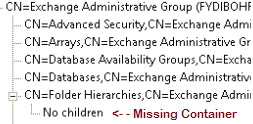1. Exchange Server 2013 /PrepareAd or Cumultive update installation fails.
Exchange server 2013 /PrepareAD or installing Cumulative Updates [ CUxx ] fail with the error,
while running Organization Preparation
The following error was generated when "$error.Clear();
install-AdministrativeGroup -DomainController $RoleDomainController
" was run: "Active Directory operation failed on Servername.domain.com. The object
'CN=Folder Hierarchies, CN=Exchange Administrative Group (FYDIBOHF23SPDLT),
CN=Administrative Groups, CN=Exchange Organization,CN=Microsoft Exchange,
CN=Services,CN=Configuration, DC=Domain,DC=Com' already exists."
The Exchange Server setup operation didn't complete. More details can be found in ExchangeSetup.log
located in the <SystemDrive>:\ExchangeSetupLogs folder. Exchange Server setup encountered an error.
This error occur when the "CN= Public Folders" container underneath 'CN=Folder Hierarchies has been
deleted from Active Directory. use the ADSI Edit, or a similar tool (LDP), to determine whether the Public
Folders container exists. The Public folder object can be found at:
CN=Configuration,CN=Services,CN=Microsoft Exchange,CN=Your Exchange Organization,
CN=Administrative Groups,CN=Administrative group,CN=Exchange Administrative Group
(FYDIBOHF23SPDLT), CN=Folder Hierarchies

There are multiple methods to fix this issue , Here is the recommended method
by Recreating Public Folders containers.
Use ADSI Edit or a similar tool to locate and expand Exchange Administrative Group (FYDIBOHF23SPDLT).
The Public Folders object can be found at:
CN=Configuration,CN=Services,CN=Microsoft Exchange,CN=Organization,CN=Administrative Groups,
CN=Exchange Administrative Group (FYDIBOHF23SPDLT),CN=Folder Hierarchies
- Right-click the Folder Hierarchies object, click New, and then click Object.
- In the Select a class list, select msExchPFTree, and then click Next.
- In the Value box, type Public Folders, and then click Next.
- Click More Attributes.
- In the Select a class list, select msExchPFTreeType, and then click Next.
- In the Edit Attribute box, type 1, click Set, click OK, and then click Finish
- Manju